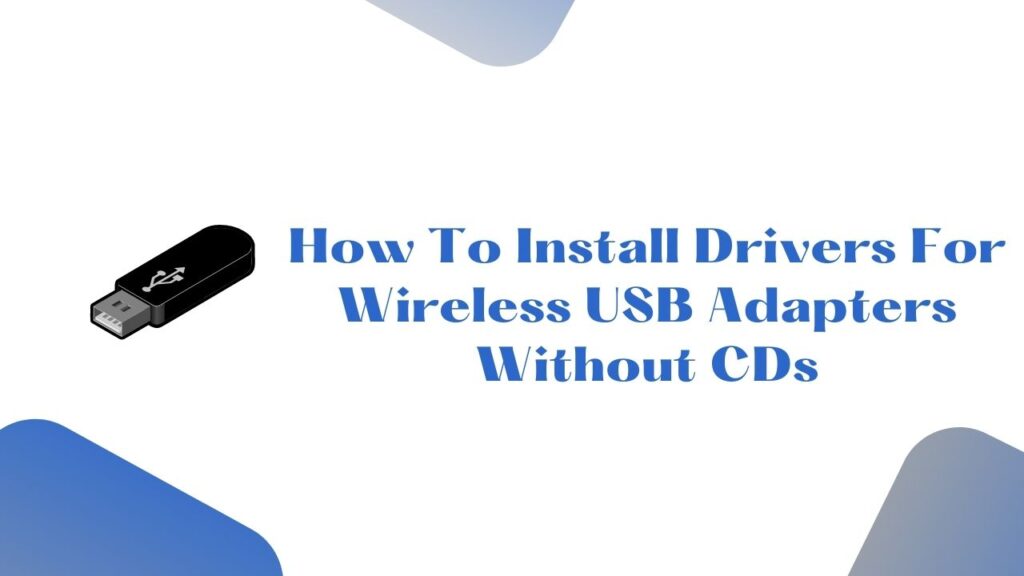
Wireless USB adapters are devices that can connect your computer to a wireless network, allowing you to access the internet from your home or office. Like any other hardware device, wireless USB adapters also require appropriate drivers in order to work efficiently and without any error.
The most convenient way of installing drivers for any hardware device is from the installation CD that comes with the device.
However, if you have recently bought a new wireless USB adapter and don’t have the installation CD, then don’t worry. In this blog post, we will show you how to install drivers for your wireless USB adapter without CDs.
Steps to Install Drivers of USB Adapters Without CDs
Here is the step-by-step guide on how you can download and install the drivers for wireless USB adapters easily on your Windows system.
Instructions for installing Wireless USB Adapters driver manually
The first step in installing drivers for a wireless USB adapter without a CD is to download the latest drivers from the manufacturer’s website. To do so, follow the below steps as instructed:
Step 1: Identify your adapter
Before you can download the drivers, you need to know the model type and model number of your adapter. If you are not sure what your adapter’s model number is, there are a few ways to find it. Here are some of the most common ways:
Check the Package: If you still have the package that your adapter came in, look for the model number on the label or in the documentation.
Check the Adapter: Many adapters have the model number printed on the device itself. Look for a small label or sticker with the model number on it.
Use Device Manager: If you have already connected your adapter to your computer, you can use Device Manager to find the model number. To do this, follow these steps:
- Press the Windows key + X and select Device Manager.
- Look for your adapter under the Network Adapters section. Right-click on your adapter and select Properties.
- Look for the model number in the Device Properties window.
Step 2: Visit the manufacturer’s websit
Most manufacturers have a support section on their website where you can find drivers and software updates. Go to the website of the manufacturer of your adapter and simply search for your adapter by name.
Once you’ve found the drivers, follow the instructions to download them to your computer. Make sure to select the correct version of the drivers for your operating system.
Step 3: Install the drivers
Once you have downloaded the latest drivers, it’s time to install them on your computer. Here’s how to do it:
- Double-click on the driver file you just downloaded.
- Follow the on-screen instructions to install the drivers. Once the installation is complete, restart your computer.
- Connect your adapter to your computer and let Windows detect and use the drivers.
Instructions for installing drivers using a third-party tool
While installing drivers manually is a straightforward process, it can take some time, especially if you need to install drivers for multiple devices. If you want to save time, you can utilize any free driver updater software available.
These applications can automatically scan your system for out-of-date drivers and update them to the latest version. With driver updater software, you don’t have to spend time searching for drivers and downloading them manually. The tool does all the work for you.
Moreover, such automatic driver updating software can assist you significantly in improving your system’s overall performance and also prevent a number of errors by consistently updating your system drivers.
Here’s how to use an automatic driver updater to install drivers for your wireless USB adapter:
Step 1: Download a free driver updater
There are many free automatic driver updater tools available online. Do a quick search to find one that you find useful and appropriate and download it to your computer.
Step 2: Install the driver updater
After downloading the driver updater, double-click the file to start the installation process. Follow the on-screen instructions to complete the installation.
Step 3: Scan for outdated drivers
Once the driver updater is installed, run a scan to see if there are any outdated drivers on your computer.
If the driver updater finds any outdated drivers, it will show you a list of the drivers that need to be updated. Select the drivers for your wireless USB adapter and click the “Update” button to start the update process.
Conclusion
In conclusion, installing drivers for wireless USB adapters without CDs is easy with the right tools. We hope all the aforementioned methods and steps were useful to you in downloading and installing the drivers easily on your system.






